Printable primary worksheets
All of our resources come complete with answer sheets to save time for busy teachers and parents. Input your child’s scores and keep track of your child's progress.
worksheet plans from £3.20/monthAll of our resources come complete with answer sheets to save time for busy teachers and parents. Input your child’s scores and keep track of your child's progress.
worksheet plans from £3.20/month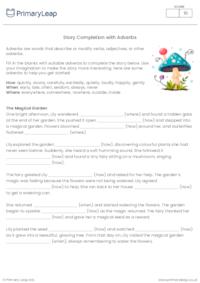
Enhance your students' understanding of adverbs with this engaging and interactive ESL printable worksheet, "Story Completion with Adverbs." Designed specifically for primary-aged children at the pre-intermediate level, this worksheet provides a creative and educational activity that supports the development of essential language skills.What's Included:A short, captivating story titled "The Magical Garden" with strategically placed blanks for adverbs.An introduction to adverbs, explaining their purpose and usage with clear examples.A list of suggested adverbs to guide students in completing the story.Fun and context-based learning that encourages creativity and comprehension.Benefits:This worksheet offers a hands-on approach to learning adverbs, allowing students to practise and apply their knowledge in a meaningful context. By filling in the blanks with appropriate adverbs, children will:Improve their understanding of how adverbs modify verbs, adjectives, and other adverbs.Develop their sentence construction and storytelling skills.Enhance their vocabulary and grasp of English grammar.Engage in a fun and imaginative activity that fosters a love for learning.Perfect for classroom use, homework assignments, or tutoring sessions, this worksheet is an excellent resource for educators and parents looking to reinforce adverb usage in an enjoyable and effective way. Download "Story Completion with Adverbs" today and watch your students' language skills flourish!
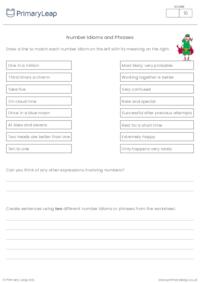
This handy worksheet will help ESL students understand number-related idioms, an important aspect of English vocabulary. By matching idioms with their meanings, students will develop their comprehension skills and learn to recognise and use these expressions in context.Benefits:Vocabulary Expansion: Students will learn eight common number idioms, which will enrich their language use and make their speech and writing more colourful and expressive.Comprehension Skills: Matching exercises help reinforce understanding of idiomatic expressions by encouraging students to think critically about meanings.Contextual Learning: By creating sentences with idioms, students will practise using these expressions in real-life scenarios, which aids in retention and practical application.Engagement: Interactive activities like matching and sentence creation make learning fun and engaging, keeping students interested and motivated.This worksheet is suitable for both classroom and home use. It is an excellent resource for teachers and parents looking to support their children in mastering English idioms and enhancing their overall language proficiency. Use this worksheet to help your students or children grasp the nuances of English idioms and boost their language skills in a fun and engaging way.
 Free
Free
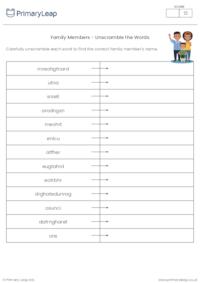
Family Members ESL Unscramble the Words WorksheetEngage your young learners in a fun and educational activity with our "Family Members ESL Unscramble the Words Worksheet." This printable worksheet is designed to help children study and practise family members' vocabulary in an enjoyable way.Students will have the opportunity to unscramble the letters of family member names, such as "grandmother," "father," "sister," and more. By unscrambling the words, students will reinforce their spelling skills while also becoming more familiar with common family vocabulary.This worksheet is perfect for ESL students, beginners, or any child looking to expand their English vocabulary. It can be used in the classroom, at home, or as part of a tutoring session. It's a versatile resource that adds an element of fun to language learning.
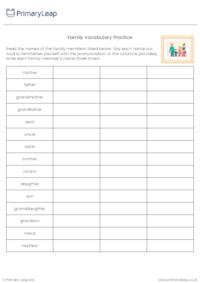
Empower your ESL students with our Family Vocabulary Practice Worksheet, designed specifically for beginners to reinforce their understanding and retention of essential family member names in English. This worksheet offers a structured and interactive approach to language learning, making it an ideal resource for educators seeking to enhance their students' vocabulary skills.With clear instructions and a user-friendly format, this worksheet encourages students to engage actively in the learning process. By writing each family member's name three times, students not only reinforce their spelling but also develop muscle memory, aiding in long-term retention of vocabulary.As educators, you can incorporate this worksheet into your lesson plans to provide valuable practice opportunities for your students. Whether used as an individual task or part of a group activity, this resource offers flexibility in implementation, catering to diverse teaching styles and classroom dynamics.Encourage your students to collaborate with peers, offering support and feedback as they work through the worksheet. This collaborative approach fosters a sense of community within the classroom and reinforces the importance of communication skills in language learning.Download our Family Vocabulary Practice Worksheet today and watch as your students gain confidence and proficiency in using family-related vocabulary.
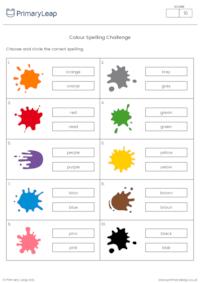
Colour Spelling ChallengeThis worksheet is a fun and educational activity that focuses on colour vocabulary and spelling. The objective of this activity is to reinforce colour-related vocabulary while improving spelling accuracy in English. The worksheet contains 10 colour swatches, each accompanied by two spelling options for the corresponding colour word (e.g., blue or bloo). Students are instructed to circle the correct spelling of each colour word based on the colour swatch provided.
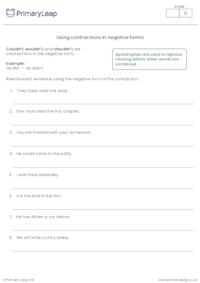
Using contractions in negative formsThis worksheet aims to reinforce the understanding of negative contractions by transforming sentences into their negative form. Students will practise using contractions such as couldn't, wouldn't, and shouldn't to express negation.
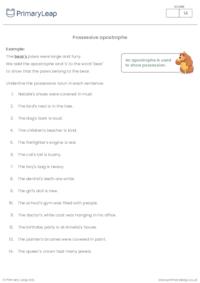
Possessive apostrophe worksheetThis worksheet will help to reinforce the concept of possessive nouns and their usage of apostrophes. Students will practise identifying possessive nouns in sentences by underlining them, promoting an understanding of ownership in language.
 Free
Free
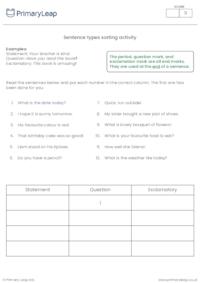
Periods, question marks, and exclamation marksUse this worksheet to help students practise identifying and categorising different types of sentences—statements, questions, and exclamatory sentences. By reading sentences and placing them in the correct column, students reinforce their understanding of sentence types.
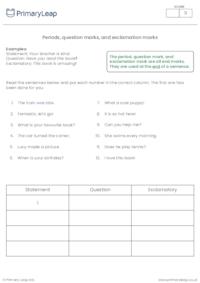
Periods, question marks, and exclamation marksUse this worksheet to help students practise identifying and categorising different types of sentences—statements, questions, and exclamatory sentences. By reading sentences and placing them in the correct column, students reinforce their understanding of sentence types.
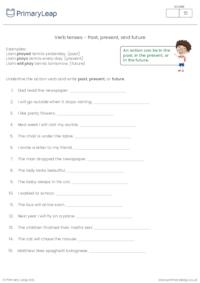
Verb tenses - Past, present, and futureUse this worksheet in the classroom or at home to help students practise identifying verb tenses, specifically focusing on past, present, and future tenses. By underlining the action verb in each sentence and indicating the corresponding time (past, present, or future), students reinforce their understanding of verb tense usage.
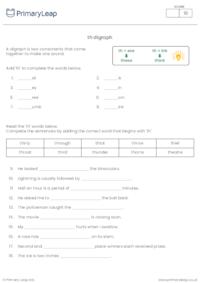
ESL 'th' digraph worksheetThis worksheet stands as an invaluable resource for ESL learners, providing a holistic and dynamic exploration of the 'th' digraph, contributing significantly to their language proficiency.
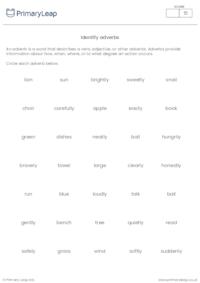
Identify adverbs worksheetBy circling adverbs, students will reinforce their understanding of how adverbs enhance language by providing information about how, when, where, or to what degree an action occurs. This worksheet is a valuable resource for educators seeking to reinforce grammar skills, improve contextual understanding, and provide practical exercises that empower ESL students to recognise and use adverbs effectively.
 Free
Free
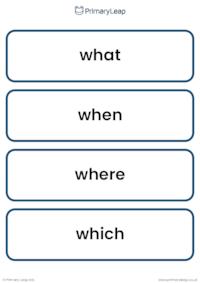
ESL Learning Cards - Question WordsQuestion words appear a lot in the English language. These vocabulary learning cards are a great way to help teach ESL students the components of reading and writing. Print these question words and laminate them so they can be used over and over again! Question words included in this set are - what, which, when, where, who, whom, whose, why, and how.
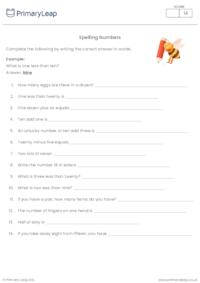
This resource is designed to provide ESL students with a dynamic and interactive approach to mastering foundational arithmetic concepts while strengthening their language skills. The worksheet strategically incorporates numerical terms and expressions commonly used in English, offering ESL students an opportunity to reinforce their language skills while engaging with arithmetic concepts. By introducing concepts like "dozen" and exploring beliefs about lucky and unlucky numbers, the worksheet not only reinforces numerical literacy but also provides cultural context, helping ESL students connect with everyday English language usage. Whether used in the classroom or assigned as homework, this worksheet provides a dynamic approach to numerical learning.Learning Objectives:Reinforce understanding of common numerical terms such as "dozen."Strengthen addition and subtraction skills within the context of basic arithmetic expressions.Encourage critical thinking and numerical literacy through various number-related concepts.
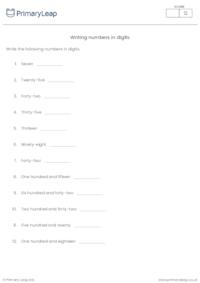
This ESL resource guides learners through the process of translating number words into numerical digits, offering a structured approach to mastering numbers up to 1000. Students will practice writing numerical digits corresponding to a diverse range of number words, covering the spectrum from single digits to triple-digit numbers. This extensive coverage ensures a well-rounded exploration of numerical literacy.
 Free
Free
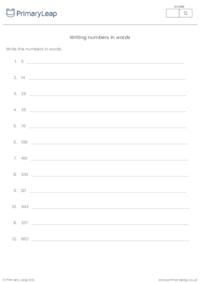
Immerse your ESL students in the world of numerical literacy with our comprehensive Number Words Worksheet with numbers up to 1000. This carefully crafted resource is designed to reinforce the association between numerical digits and their written word counterparts, providing a valuable foundation for numerical literacy. The "Number Words Worksheet for ESL Students is a versatile and valuable resource for ESL educators, offering a structured and engaging approach to numerical literacy. Whether used in the classroom or assigned as homework, this worksheet is designed to support ESL students in mastering the language associated with numbers.
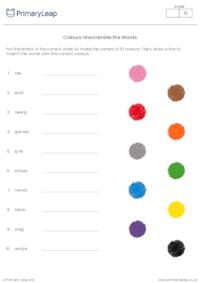
This engaging resource seamlessly integrates language learning with visual recognition, offering an interactive exercise to reinforce colour vocabulary. Students are presented with ten scrambled colour names, such as "eubl," which unscrambles to "blue." Their task is to decode the letters, practising spelling and reinforcing colour vocabulary in the process. Once the colour names are unscrambled, students are prompted to match each correctly spelled colour to its corresponding picture.Learning Objectives:Develop and reinforce colour vocabulary in English.Enhance spelling and word recognition skills.Strengthen the association between written words and visual representations of colours.Whether used in the classroom or for independent study, this worksheet is designed to make the learning experience enjoyable for ESL students.
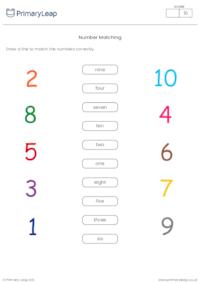
Engage your ESL students in an interactive and skill-building activity with our Number Matching Worksheet. This resource is thoughtfully designed to reinforce the connection between numerical words and their corresponding numerals, providing a foundation for numerical literacy. Students are presented with a list of numerical words (e.g., "five," "eight") alongside a set of numerals (e.g., "5," "8"). The task is to draw a line connecting each numerical word to its corresponding numeral, fostering recognition of both written and numerical representations of numbers. The worksheet is suitable for independent completion or as a pair activity. Students can work individually or collaborate with a partner to reinforce their understanding of numerical words and numerals. Learning Objectives:Develop recognition and association skills between numerical words and numerals.Enhance written and numerical literacy in English.Reinforce understanding of numbers within a given range.The Number Matching Worksheet is a versatile and effective resource for ESL educators, providing a hands-on approach to learning numerical vocabulary. Whether used in the classroom or as part of a homework assignment, this worksheet supports the development of essential language and numerical skills in an engaging manner.
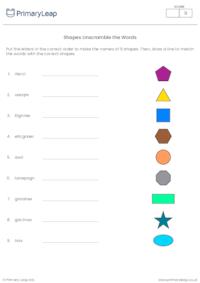
Shapes Unscramble the Words ActivityThis resource for ESL students combines language development with visual recognition, offering a comprehensive exercise to reinforce shape vocabulary. Students are presented with nine scrambled shape names, such as "rlecci" for "Circle" and "uasqre" for "Square." Their task is to unscramble the letters, practising spelling and reinforcing shape vocabulary in the process. Once the shapes are unscrambled, students are prompted to match each correctly spelled shape to its corresponding picture. The worksheet includes a variety of shapes, from basic circles and squares to more intricate ones like pentagons and hexagons. This ensures a well-rounded learning experience, exposing students to a range of geometric vocabulary.Ideal for individual practice, students can work on the worksheet at their own pace, allowing for independent exploration of shape names.Encourage collaboration by having students work in pairs or small groups to unscramble the words and match them to the pictures. This fosters teamwork and peer learning.Use the worksheet as a review activity to reinforce shape vocabulary after a lesson. Learning Objectives:Develop and reinforce shape vocabulary in English.Enhance spelling and word recognition skills.Strengthen the association between written words and visual representations.Whether used in the classroom or for independent study, this worksheet is designed to make the learning experience enjoyable for ESL students.
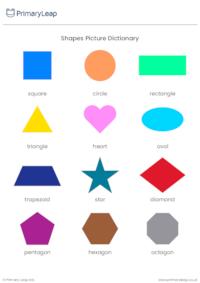
Basic Shapes DictionaryThis resource serves as a time-saving and effective teaching aid. The colourful picture dictionary allows for easy integration into lesson plans, while the comprehensive coverage of shapes ensures a well-rounded curriculum that supports ESL students at various proficiency levels. Our picture dictionary features 12 basic shapes, each accompanied by a vibrant and clear illustration. Visual aids play a crucial role in language acquisition, allowing ESL students to associate English words with concrete images, facilitating better understanding and retention. By combining visual stimuli, vocabulary reinforcement, and interactive elements, this resource paves the way for an engaging and successful language learning journey.
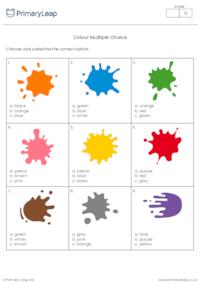
This handy worksheet will help enhance students' colour recognition skills through visual and interactive learning. In this exercise, students will encounter nine vibrant pictures, each accompanied by three answer options. The goal is simple: to underline the correct colour associated with each image. The repetition of colour recognition through multiple pictures and options reinforces the learning, helping ESL learners internalise the vocabulary over time. As students engage with the challenge, they may discuss their choices, providing opportunities for verbal communication and language practice.
 Free
Free
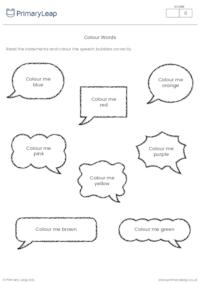
ESL reading and colouring activityStudents are asked to colour the speech bubbles according to the colour written. This is good practice for reading colours.
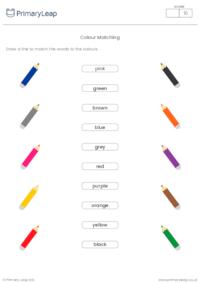
Colour matching activityStudents read the names of the colours and draw a line to match the words to the pictures. This is good practice for reading colours.
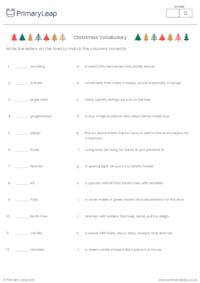
Christmas Vocabulary Matching ActivityPupils will enjoy exploring the festive vocabulary associated with the magical holiday season in this charming worksheet! This worksheet is a perfect blend of holiday joy and language exploration, offering students an entertaining way to embrace and celebrate Christmas vocabulary.
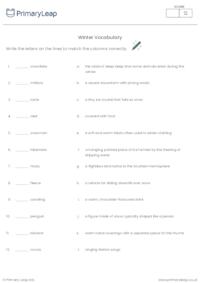
Winter Vocabulary Matching ActivityThis activity aims to make learning about winter both educational and fun, fostering a love for language and the wonders of the cold season. Students will learn vocabulary associated with the enchanting season of winter. In this worksheet, learners will have the exciting opportunity to match 12 winter-related words with their simple and engaging definitions.
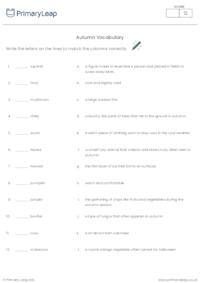
Autumn Vocabulary Matching ActivityThis engaging activity is designed for students to explore and expand their vocabulary related to the enchanting season of autumn. In this worksheet, students will have the exciting opportunity to match 25 autumn-related words with their easily understandable definitions. The words include familiar terms such as "leaves," "harvest," and "pumpkin."
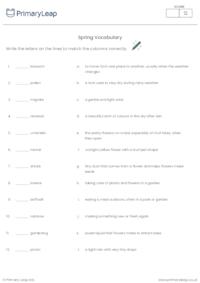
Spring Vocabulary Matching ActivityThis fun and educational activity is designed for students to explore the words and meanings associated with the delightful season of spring. In this worksheet, students will have the opportunity to match 12 spring-related words with their easy-to-understand definitions. This activity aims to make learning about spring enjoyable and accessible, fostering a love for language and the natural world. Happy matching and exploring the signs of spring!




Check out our ready-to-use worksheets that can be used in the classroom or at home. Simply download or print and watch your child’s confidence grow with our easy to follow printables.


One of the best things about printable worksheets is that they make learning fun and easy. Explore our educational resources based on and keep your children learning through these fun and engaging exercises.


Our printable worksheets are designed for progressive learning. Our engaging content enables a child to learn at their own speed and gain confidence quickly. When we help a child believe in themselves, we empower them for life.


Printable worksheets are a great way to enhance creativity and improve a child’s knowledge. Help your child learn more about with this great selection of worksheets designed to help children succeed.
An email has been sent to your account please activate your account to continue.

PrimaryLeap has introduced a new interactive learning platform and would like to offer you a completely Free Upgrade.
We understand that you may only want to use our services for worksheets and may not want to upgrade your account.
But if you are interested in trying out our new services then you're just a click away.
An email has been sent to your account please activate your account to continue.
You've answered
and have 2 Questions remaining
Import multiple students information through a CSV File. Browse or drag .CSV file below.